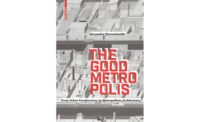Martin Filler, the architecture critic who has appeared in The New York Review of Books since 1985, now gives us his third anthology of these essays on modern architects. Most are devoted to historical figures of the last century, some revered (Frederick Law Olmsted), some notorious (Albert Speer), and some inexcusably forgotten (Jan Duiker, designer of Holland’s brilliant Zonnestraal sanatorium, 1931). Although Filler’s essays are usually prompted by a new publication or even exhibition about the subject, they are considerably more than book reviews. His concern is to show why these subjects remain of perennial interest to us—or, in some cases, do not. There is a great deal of pleasantly opinionated revisionism.
Filler is baffled by the ongoing rehabilitation of Paul Rudolph, America’s furiously imaginative Brutalist. His Yale Art & Architecture building was a “preposterous overelaboration of space,” and his bewildering New York apartment, with its odd array of suspended catwalks and floating platforms, forced visitors to huddle nervously, like Eliza “on the ice floes.” Rudolph’s weakness was not his chilly Brutalism but his own aggressively introverted personality, with none of the larger sense of humanity that Filler finds in Louis Kahn, one of his heroes.
Especially rewarding are Filler’s pieces about his native New York. He shows how Daniel Libeskind was chosen to redesign the World Trade Center site, only to be deftly outmaneuvered by David Childs and SOM, who had been commissioned to renovate the towers weeks before they were destroyed, and who had no intention of relinquishing the commission. Those who understand how political and financial power work in New York were not surprised to see “the clueless tyro Libeskind, nominal master planner of the Trade Center site, blown away like tumbleweed.”
Filler’s most incendiary essay concerns New York’s flashy residential towers of the last few years, most notoriously Rafael Viñoly’s stiletto-thin 432 Park Avenue. These “smokestack-like protuberances,” Filler laments, are filled in large part with pieds-à-terre owned by “foreign nationals eager to secure a foothold in the U.S. in the event of trouble in their homelands.” How different from their proud Art Deco ancestors of the 1920s, which represented a faith and confidence in the city they graced.
Some of Filler’s judgments are surprising. I could have guessed that he would despise William J. Levitt, the creator of Levittown (“the whitebread world of Eisenhower-era cookie-cutter suburbia”), but I was shocked by his admiration for Edwin Lutyens. After all, his design for the President’s House in New Delhi presented a swaggering image of colonial domination. In Filler’s telling, Lutyens emerges as an immensely appealing eccentric, who found solace from his claustrophobic marriage in a curious affair with Victoria Sackville-West (no offspring, but three houses). True, no other architect could match the inconceivable tragedy of World War I, and Filler aptly stands in awe of his sublime monument at Thiepval to the 72,000 missing of the Battle of the Somme, an anti-triumphal arch that is “part cathedral, part watchtower, part sphinx.”
Those who are interested in the way that architecture reveals the vagaries of the human heart will not be disappointed by this acerbic, occasionally poignant collection.






Post a comment to this article
Report Abusive Comment